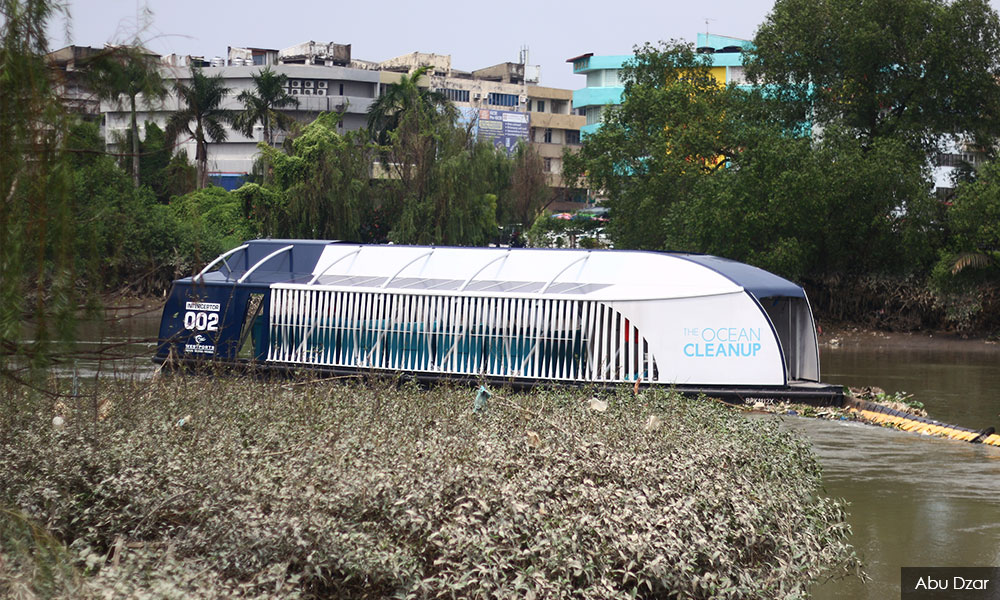
Hiring a river cleaning machine, the Interceptor, and installing log booms help in efforts to clean up the Klang River - but what happens to the collected debris?
The Interceptor, a solar-powered autonomous machine that sifts through rivers to stop debris from entering the oceans, is an innovation in river cleaning invented by Dutch NGO Ocean Clean Up, founded by young inventor Boyan Slat.
But the Interceptor is only one part of the equation to tackle the waste issue, said Landasan Lumayan Sdn Bhd managing director Syaiful Azmen Nordin.
This is because the tonnes of debris collected will then need to be transported and disposed of in a landfill, he said in an interview last week.
“There are a lot of potentials (for the Klang River to) become a new engine force in Selangor. But the first thing that we have to deal with is the debris, said Syaiful (photo), who heads the Selangor government company leading the river clean-up project called the Selangor Maritime Gateway (SMG).

“Actually we can prevent this problem from happening by not throwing plastic waste into the river. To me, river cleaning (alone) is not sustainable.”
“The Selangor government is committed to this project. It is now the community’s turn to spread the information about (reducing) the waste,” he added.
To avoid sending waste to landfill, Syaiful said, the SMG is now looking at how it can recycle or reuse more of the river debris, to create what is called a circular economy.
He said of the debris collected so far, only some plastic waste is found to be recyclable.
From 50K tonnes of waste to just 800 tonnes
Malaysia is the second country to use the Interceptor after the invention underwent prototyping in Jakarta earlier this year.
The Interceptor 002, now in the Klang River, was assembled in Port Klang from July to August. It was tested on Aug 15 and launched on Oct 26.
Syaiful said the Ocean Cleanup approached the federal government to propose the collaboration in November 2018 and an agreement was signed in April 2019.
The Interceptor 002 will be used on the Klang River for one year free of charge. If the government decides to extend its use, it will need to buy it for 700,000 euros (RM3.2 million).
The next country to have The Interceptor is Vietnam.

Syaiful said there were an estimated 50,000 metric tonnes of waste - about the weight of 9,000 Asian elephants - in the Klang river before the clean-up effort.
Today, with the Interceptor’s help, the quantum has been reduced to about 800 metric tonnes - or equivalent to 145 Asian elephants.
“Generally, 30 to 40 percent are plastic. Then we have organic waste, wood, furniture, tyres, and even a teddy bear.”
Top 50 most polluted rivers
According to The Ocean Cleanup, the Klang River is one of the top 50 most polluted rivers in the world.
After removing the waste, the water quality improved tremendously from Class V to Class III on the water quality index.
Rivers under Class V are generally known as “dead rivers” and cannot be safely used for irrigation or human and animal consumption, while water from Class III rivers can be used as water supply with extensive treatment and for fisheries and livestock drinking.
Besides the Interceptor, the company LLSB also installed log booms in to catch the floating debris on the Klang River.
“Now we have seven log booms along the Klang River. From Petaling Jaya which has three log booms, and Subang Jaya, Shah Alam and Klang. So you can see the impact of our work,” he said.

A log boom is a barrier placed in a river, designed to collect and or contain debris at river mouths.
The seven log booms on the Klang River act as a trap for most of the waste, while The Interceptor collects waste which slips through the booms.
River taxis along Klang River soon
Selangor Menteri Besar Amirudin Shari launched the first of several phases of the SGM project last month. Besides cleaning, the other phases are rehabilitation and urban rejuvenation.
The project is expected to be completed in the second quarter of 2020.
The second phase involves rehabilitating the defunct Toluk Kapas landfill, so the revitalised site can be used for community projects.
For the urban rejuvenation phase, Taman Awam Pangkalan Batu will be revived as a playground and park while a mangrove park will be developed for eco-tourism.
The project also involves developing a new river taxi transportation system with the River Taxi project on Klang River, and many more. - Mkini





No comments:
Post a Comment
Note: Only a member of this blog may post a comment.